XYZ is a large manufacturing organisation which employs 200 skilled staff in its factory in Bolton. It has a large global supply chain with raw materials sourced from Asia and Africa. Discuss five areas of policy that can affect the people working in the supply chain
See the complete answer below in Explanation.
Five Areas of Policy Affecting People in the Supply Chain – XYZ Manufacturing
Introduction
Aglobal supply chaininvolves multiple stakeholders, including suppliers, logistics providers, and factory workers. Policies atcorporate, national, and international levelsimpact theworking conditions, rights, and well-beingof people within the supply chain.
For XYZ, alarge manufacturing company with a factory in Bolton and suppliers in Asia and Africa, key policy areas affecting its workforce and supply chain workers includelabor rights, health and safety, wages, environmental regulations, and ethical sourcing.
1. Labor Laws and Workers’ Rights Policies
Policies related toemployment laws, working hours, and fair treatmentimpact supply chain workers’ rights.
✅Key Areas of Impact
Child labor and forced laborlaws ensure ethical sourcing.
Working hours and overtime regulationsprevent worker exploitation.
Freedom of association(e.g., the right to join trade unions) allows collective bargaining.
????Example:TheInternational Labour Organization (ILO) conventionsset global labor standards, influencing suppliers in Asia and Africa.
✅Impact on XYZ
Mustaudit suppliersto ensure compliance withfair labor policies.
Risk of reputational damage if suppliers engage inunethical labor practices.
2. Health and Safety Regulations
Policies ensuringsafe working conditionsin manufacturing and supply chain operations protect employees from hazards.
✅Key Areas of Impact
Workplace safety(e.g., protective equipment, fire prevention, accident reporting).
Factory compliance withOSHA (Occupational Safety and Health Administration) standards.
COVID-19 and pandemic-related health protocolsin global supply chains.
????Example:Bangladesh’sRana Plaza factory collapse (2013)highlighted the dangers of weak safety regulations, prompting global reforms in factory safety policies.
✅Impact on XYZ
Needs to conductsupplier auditsto ensurecompliance with safety laws.
May need to invest inbetter safety trainingfor factory workers in Bolton.
3. Wages and Fair Pay Policies
Regulations and policies onminimum wages, equal pay, and fair compensationinfluence worker conditions in global supply chains.
✅Key Areas of Impact
Minimum wage lawsin supplier countries affect labor costs.
Fair pay policiesensure workers are not underpaid or exploited.
Gender pay equitypromotes inclusive employment practices.
????Example:TheUK’s National Minimum Wageensures fair pay, but wages inAsia and Africamay be significantly lower.
✅Impact on XYZ
Needs to ensure supplierspay living wagesto avoid reputational risks.
Could facesupply chain disruptionsif wage disputes lead to strikes or protests.
4. Environmental and Sustainability Policies
Environmental policies regulate how businessessource raw materials, manage waste, and reduce carbon emissions.
✅Key Areas of Impact
Deforestation and raw material sourcing laws(e.g., FSC-certified timber, conflict minerals regulations).
Carbon emissions policiesaffect logistics and transportation.
Waste disposal and pollution regulationsimpact factory operations.
????Example:TheEU’s Carbon Border Adjustment Mechanism (CBAM)affects importers sourcing from high-carbon-emitting regions.
✅Impact on XYZ
Must ensuresuppliers meet environmental standardsto avoid legal penalties.
Needs toreduce carbon footprintby choosingsustainable transportand materials.
5. Ethical Sourcing and Corporate Social Responsibility (CSR) Policies
Ethical sourcing policies ensure companies buy fromresponsible suppliersthat uphold human rights and environmental protection.
✅Key Areas of Impact
Modern Slavery Act (UK, 2015)requires firms toreport on anti-slavery efforts.
Fairtrade and ethical certificationpolicies ensure responsible supply chain practices.
CSR commitmentsrequire businesses to engage in community welfare programs.
????Example:Nestléhas anEthical Sourcing Programfor cocoa, ensuring child labor-free supply chains.
✅Impact on XYZ
Needs to conductsupplier due diligenceto comply with ethical sourcing laws.
Ethical policies canenhance brand reputation and customer trust.
Conclusion
Policies onlabor rights, health and safety, fair wages, environmental sustainability, and ethical sourcingdirectly impactpeople working in XYZ’s supply chain. To ensure compliance, XYZ must adoptrobust supplier audits, transparent reporting, and ethical business practicesto protect workers' rights while maintaining aresilient and responsible supply chain.
Explain the use of forward and future contracts in the commodities market
See the complete answer below in Explanation.
Use of Forward and Futures Contracts in the Commodities Market
Introduction
Thecommodities marketinvolves the trading of physical goods such asoil, gold, agricultural products, and metals. Due toprice volatility, businesses and investors usederivative contractslikeforward and futures contractsto manage price risk and ensure stability in supply chains.
Both contracts allowbuyers and sellers to agree on a fixed price for a future date, but they differ in terms ofstandardization, trading methods, and risk exposure.
1. Forward Contracts????(Private, Custom Agreements)
Definition
Aforward contractis acustomized agreementbetween two parties tobuy or sell a commodity at a specified price on a future date. It is aprivate, over-the-counter (OTC) contract, meaning it isnot traded on an exchange.
✅Key Characteristics:
Customizable terms(quantity, delivery date, price).
Direct agreement between buyer and seller.
Used forhedging against price fluctuations.
????Example:Acoffee produceragrees to sell 10,000kg of coffee to a distributor in 6 months at afixed price of$5 per kg, protecting both parties from price swings.
Advantages of Forward Contracts
✔Tailored to buyer/seller needs– Customizable quantity, quality, and delivery terms.✔Reduces price uncertainty– Locks in a price, protecting against market fluctuations.✔No upfront cost– No initial margin or collateral required.
Disadvantages of Forward Contracts
❌High counterparty risk– If one party defaults, the other may face financial losses.❌Not regulated or publicly traded– Higher risk of contract disputes.❌Limited liquidity– Harder to transfer or sell compared to futures contracts.
????Best for:Companies looking forcustomized price protection in procurement or sales(e.g., food manufacturers, oil refineries).
2. Futures Contracts????(Standardized, Exchange-Traded Agreements)
Definition
Afutures contractis astandardized agreementto buy or sell a commodity at a predetermined price on a future date. These contracts aretraded on organized exchanges(e.g.,Chicago Mercantile Exchange (CME), London Metal Exchange (LME)).
✅Key Characteristics:
Highly regulated and standardized(fixed contract sizes and terms).
Exchange-traded→ Increased liquidity and price transparency.
Requiresinitial margin and daily settlements(mark-to-market system).
????Example:A wheat farmer usesfutures contracts on the Chicago Board of Trade (CBOT)to lock in wheat prices before harvest, avoiding potential price drops.
Advantages of Futures Contracts
✔Lower counterparty risk– Exchanges guarantee contract settlement.✔High liquidity– Easily bought or sold on futures markets.✔Price transparency– Publicly available pricing and standardized contracts.
Disadvantages of Futures Contracts
❌Less flexibility– Fixed contract sizes and expiration dates.❌Margin requirements– Traders must maintain a margin account, requiring cash reserves.❌Potential for speculative losses– Prices fluctuate daily, leading to possible margin calls.
????Best for:Large-scale buyers/sellers, investors, and companies needingrisk management in commodity markets.
3. Key Differences Between Forward and Futures Contracts
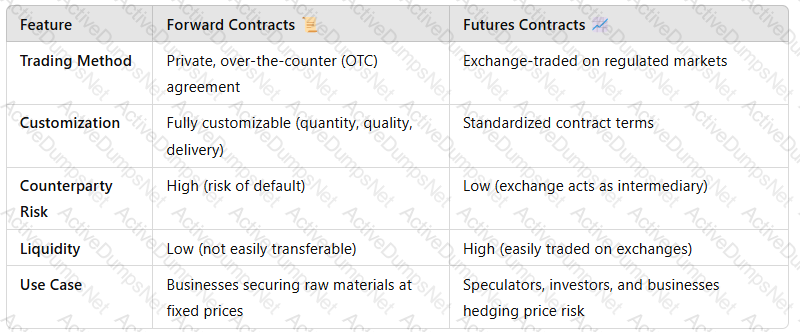 A screenshot of a computer screen
Description automatically generated
A screenshot of a computer screen
Description automatically generated
Key Takeaway:Forwards offer flexibility but higher risk, whilefutures provide standardization and liquidity.
4. Application of Forward and Futures Contracts in the Commodities Market
Forwards Used By:
✅Food manufacturers– Locking in wheat, sugar, or coffee prices for future production.✅Oil refineries– Securing crude oil prices to manage fuel costs.✅Mining companies– Pre-agreeing on metal prices to secure revenue streams.
Futures Used By:
✅Airlines– Hedging against fluctuating fuel prices.✅Investors– Speculating on gold, oil, or agricultural prices for profit.✅Governments– Stabilizing national food or energy reserves.
5. Conclusion
Bothforward and futures contractsare essential tools in thecommodities marketforprice risk management.
✅Forward contractsarecustomizable but riskier, making them suitable forbusinesses with specific procurement needs.✅Futures contractsofferliquidity and reduced counterparty risk, making them ideal forinvestors and large corporations managing price volatility.
Organizations mustchoose the right contractbased on theirrisk tolerance, market exposure, and financial objectives.
XYZ is a toilet paper manufacturer based in the UK. It has 2 large factories employing over 500 staff and a complex supply chain sourcing paper from different forests around the world. XYZ is making some strategic changes to the way it operates including changes to staffing structure and introducing more automation. Discuss 4 causes of resistance to change that staff at XYZ may experience and examine how the CEO of XYZ can successfully manage this resistance to change
See the complete answer below in Explanation.
Causes of Resistance to Change & Strategies to Manage It – XYZ Case Study
When XYZ, a UK-based toilet paper manufacturer, implementsstrategic changessuch asstaff restructuring and automation, employees mayresist changedue to uncertainty, fear, and disruption to their work environment. Below arefour key causes of resistanceand how theCEO can manage them effectively.
Causes of Resistance to Change
1. Fear of Job Loss
????Cause:Employees may fear thatautomationwill replace their jobs, leading to layoffs. Factory workers and administrative staff may feel particularly vulnerable.
????Example:If machines take over manual processes like paper cutting and packaging, employees may see this as a direct threat to their roles.
2. Lack of Communication and Transparency
????Cause:When managementfails to communicatethe reasons for change, employees may speculate and assume the worst.Unclear messageslead to distrust.
????Example:If XYZ’s CEO announces restructuring without explainingwhyandhowjobs will be affected, employees may feel insecure and disengaged.
3. Loss of Skills and Status
????Cause:Some employees, especiallylong-serving workers, may feel their skills are becoming obsolete due to automation.Managersmay resist change if they fear losing power in a new structure.
????Example:A production line supervisor mayoppose automationbecause it reduces the need for human oversight, making their role seem redundant.
4. Organizational Culture and Habit
????Cause:Employees are accustomed tospecific ways of working, andsudden changes disrupt routine. Resistance occurs when changes challengeexisting work culture.
????Example:XYZ’s employees may havealways used manual processes, and shifting toAI-driven productionfeels unfamiliar and uncomfortable.
How the CEO Can Manage Resistance to Change
1. Effective Communication Strategy
✅What to do?
Clearly explainwhy the changes are necessary(e.g., cost efficiency, competitiveness).
Usetown hall meetings, emails, and team discussionsto provide updates.
Addressemployee concernsdirectly to reduce uncertainty.
????Example:The CEO can sendmonthly updateson automation, ensuring transparency and reducing fear.
2. Employee Involvement and Engagement
✅What to do?
Involve staff indecision-makingto give them a sense of control.
Createcross-functional teamsto gather employee input.
Provide opportunities forfeedback and discussion.
????Example:XYZ canform a worker’s advisory panelto gather employee concerns and address them proactively.
3. Training and Upskilling Programs
✅What to do?
Offertraining programsto help employees adapt to new technologies.
Providereskilling opportunitiesfor employees whose jobs are affected.
Reassure staff that automation willcreate new roles, not just eliminate jobs.
????Example:XYZ can introducedigital skills trainingfor workers transitioning from manual processes to automated systems.
4. Change Champions & Support Systems
✅What to do?
Appointchange champions(influential employees) to advocate for change.
Offeremotional and psychological support(e.g., HR consultations, career guidance).
Recognize and reward employees whoembrace change.
????Example:XYZ can offerbonuses or promotionsto employees who successfully transition into new roles.
Conclusion
Resistance to change is natural, but theCEO of XYZ can minimize resistancethroughclear communication, employee involvement, training, and structured support. By managing resistance effectively, XYZ can ensure asmooth transitionwhile maintaining employee morale and operational efficiency.
Discuss how XYZ, a global beverage manufacturing organisation, could use the Boston Consultancy Group Framework to impact upon strategic decision making
Introduction
TheBoston Consulting Group (BCG) Matrixis a strategic tool used by organizations to analyze their product portfolio and allocate resources effectively. It classifies products intofour categories—Stars, Cash Cows, Question Marks, and Dogs—based onmarket growth rateandmarket share.
As aglobal beverage manufacturing organization, XYZ can use theBCG Matrixto evaluate its product range, identify growth opportunities, and make informed strategic decisions.
1. Explanation of the BCG Matrix
TheBCG Matrixis divided into four quadrants:
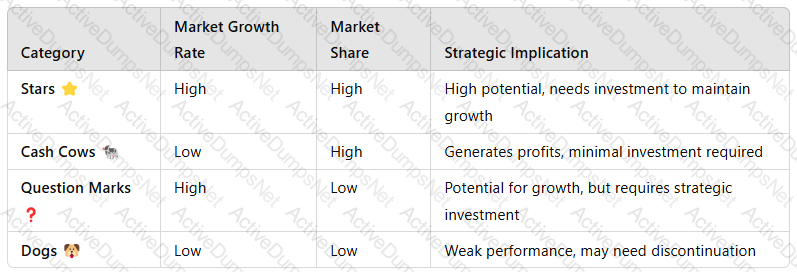
Example for XYZ:
Star:A fast-growingenergy drinkbrand in emerging markets.
Cash Cow:A flagshipcola productwith stable market demand.
Question Mark:A newfunctional health drinkwith uncertain market acceptance.
Dog:An underperformingdiet soda variantwith declining sales.
2. How XYZ Can Use the BCG Matrix for Strategic Decision-Making
XYZ can use the BCG Matrix to makeresource allocation and investment decisionsbased on product performance.

3. Advantages of Using the BCG Matrix for XYZ
✅Resource Allocation– Helps prioritize investment in high-growth products.
✅Strategic Focus– Identifies which products to grow, maintain, or phase out.
✅Market Adaptation– Helps XYZ adjust its beverage portfolio based on changing consumer trends.
????Example:IfXYZ’s energy drink(a Star) is experiencing high growth, more marketing and production investment may be justified.
4. Limitations of the BCG Matrix
❌Ignores Market Competition– A product may have a high market share, but competition could still impact profitability.
❌Simplistic Assumptions– Not all products neatly fit into one category; market dynamics are complex.
❌Focuses on Growth and Share Only– It does not consider external factors likeprofit margins, customer loyalty, or brand strength.
????Example:AQuestion Mark productmight have potential, but if consumer preferences shift, it may never become a Star.
5. Application of the BCG Matrix in the Beverage Industry
XYZ can apply theBCG Matrixby reviewing itsentire product portfolioacross different geographic markets.

Conclusion
TheBCG Matrixis a valuable strategic tool for XYZ to analyze itsproduct portfolio, prioritize investments, and make informedmarket-based decisions. However, it should be used alongside otherstrategic models(e.g.,PESTLE, VRIO) to ensure acomprehensive business strategy.
See the complete answer below in Explanation.
Boston Consulting Group (BCG) Matrix and Strategic Decision-Making for XYZ
Explain how culture and historic influences can impact upon a business’s strategic decisions and positioning within the marketplace
See the complete answer below in Explanation.
How Culture and Historic Influences Impact Strategic Decisions and Market Positioning
A business’sstrategic decisionsandpositioning within the marketplaceare shaped by bothorganizational cultureandhistorical influences. These factors affect how a companydevelops strategy, interacts with customers, manages employees, and competes globally.
1. The Role of Organizational Culture in Strategic Decisions
Organizational culture is theshared values, beliefs, and behaviorswithin a company. It influencesdecision-making, innovation, and competitive advantage.
????How Culture Affects Strategy
✅Risk Appetite– A culture that embraces innovation (e.g., Google) will invest in R&D, while risk-averse cultures (e.g., traditional banks) focus on stability.✅Decision-Making Speed– Hierarchical cultures (e.g., Japanese firms) rely on consensus, while Western firms (e.g., Apple) may have centralized decision-making.✅Customer Engagement– Acustomer-centric culture(e.g., Amazon) leads to investment in personalization and AI-driven recommendations.
????Example:
Toyota’s Kaizen Culture (Continuous Improvement)has shaped itslean manufacturing strategy, giving it a competitive advantage in cost efficiency.
2. How Historic Influences Shape Business Strategy
Historical events,past business performance, economic trends, and industry evolutionshape how businessesposition themselves in the marketplace.
????How History Affects Strategy
✅Legacy of Innovation or Conservatism– Companies with a history ofinnovation(e.g., IBM, Tesla) continuously push boundaries, while firms with traditional roots (e.g., British banks) focus on risk management.✅Economic Crises and Financial Stability– Businesses that survived financial crises (e.g., 2008 recession) tend to developrisk-averse financial strategies.✅Market Reputation and Consumer Perception– A stronghistorical reputationcan be leveraged for branding (e.g., Rolls-Royce’s luxury image).
????Example:
Legonearly went bankrupt in the early 2000s, leading it toredefine its strategy, focus ondigital gaming partnerships, and revive its brand.
3. The Influence of National and Corporate Culture on Global Positioning
When expanding globally, businesses mustalign their strategies with different cultural expectations.
????How Culture Affects Global Market Entry
✅Consumer Preferences– Fast food chainsadapt menusfor local cultures (e.g., McDonald's in India offers vegetarian options).✅Negotiation & Communication Styles– Business negotiations inChinaemphasize relationships ("Guanxi"), whileWestern firmsprioritize efficiency.✅Leadership and Management Approaches–German firmsemphasize engineering precision, whileSilicon Valley firmsprioritize agility and experimentation.
????Example:
IKEAmodifies store layouts in different countries—small apartments in Japan vs. large home spaces in the U.S.
4. Strategic Positioning Based on Cultural & Historic Factors
A company’s historical and cultural influences define itspositioning strategy:
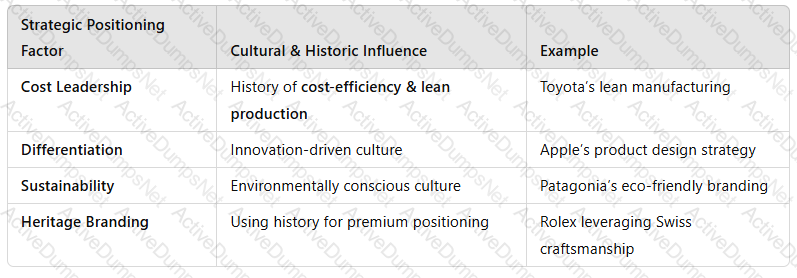 A screenshot of a white box
Description automatically generated
A screenshot of a white box
Description automatically generated
Conclusion
A business’sstrategic decisions and market positioningare deeply influenced byorganizational culture, national culture, and historical performance. Companies thatleverage their cultural strengths and adapt to market historycan achievelong-term competitive advantage.
Assess benchmarking as an approach to analysing an organisations performance.
See the complete answer below in Explanation.
Benchmarking as an Approach to Analyzing Organizational Performance
Introduction
Benchmarking is aperformance measurement toolused by organizations tocompare their processes, products, or servicesagainst industry standards, competitors, or best practices. It helps organizationsidentify performance gaps, set improvement targets, and enhance competitive advantage.
There are different types of benchmarking, includinginternal, competitive, functional, and generic benchmarking, each serving different strategic objectives.
1. Types of Benchmarking
Organizations can adopt different benchmarking approaches based on their goals:
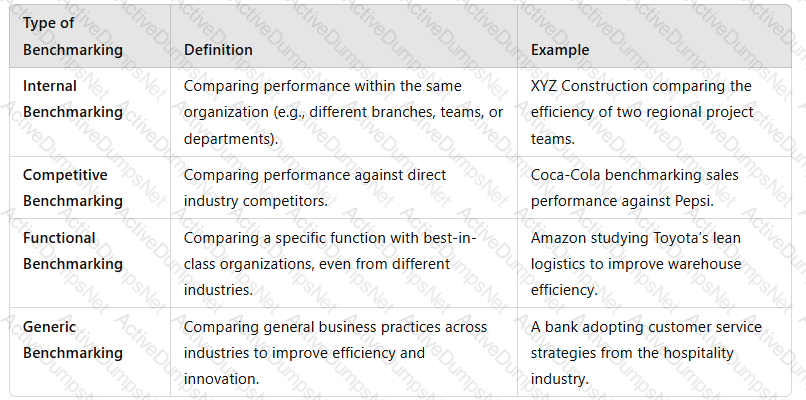 A screenshot of a computer
Description automatically generated
A screenshot of a computer
Description automatically generated
2. How Benchmarking Helps in Performance Analysis
Benchmarking providesquantifiable insightsto assess and improve organizational performance in key areas:
✅Identifies Performance Gaps– Highlights areas where an organization lags behind competitors or industry best practices.✅Improves Operational Efficiency– Helps streamlinesupply chain, production, and customer service processes.✅Enhances Strategic Decision-Making– Supports data-driven decisions forresource allocation, pricing strategies, and process optimization.✅Drives Continuous Improvement– Encourages a culture ofinnovation and best practice adoption.✅Boosts Competitive Advantage– Enables organizations to stay ahead in their market by implementing superior processes.
????Example:Aretail chain benchmarking delivery speed against Amazonmay adoptAI-driven inventory managementto reduce delays.
3. Advantages of Benchmarking
✅Objective Performance Measurement– Uses industry data to providerealistic performance targets.✅Encourages Best Practice Adoption– Helps companieslearn from successful competitors.✅Enhances Cost Efficiency– Identifiesareas for cost reduction and resource optimization.✅Facilitates Strategic Growth– Helps companies improvecustomer experience, product innovation, and market positioning.
????Example:McDonald's benchmarked Starbucks' digital loyalty program, leading to the launch ofMyMcDonald’s Rewards, improving customer retention.
4. Limitations of Benchmarking
❌Limited to Available Data–Confidential industry datamay not always be accessible.❌Lack of Context– Differences inbusiness models, resources, and market conditionscanmake direct comparisons misleading.❌Focus on Imitation Over Innovation– Firms may focus too much oncopying competitorsrather than developing unique strategies.❌Resource-Intensive– Conducting in-depth benchmarking requirestime, expertise, and financial investment.
????Example:XYZ Construction benchmarking against a large multinationalmay find certain strategies unrealistic due toscale differences.
5. Application of Benchmarking in Different Sectors
Organizations across industries use benchmarking for performance analysis:
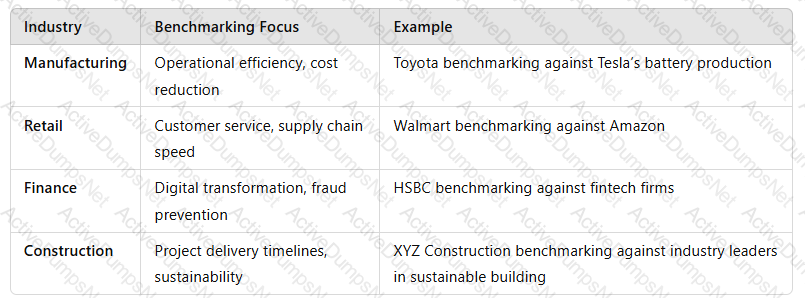 A screenshot of a computer
Description automatically generated
A screenshot of a computer
Description automatically generated
Conclusion
Benchmarking is aneffective performance analysis toolthat helps organizationsidentify gaps, adopt best practices, and enhance competitiveness. However, it must be used carefully toavoid blind imitation and consider contextual differences. When integrated with other strategic models (e.g., SWOT, Balanced Scorecard), benchmarking provides apowerful framework for continuous improvement and strategic growth.
Evaluate diversification as a growth strategy. What are the main drivers and risks?
See the complete answer below in Explanation.
Evaluation of Diversification as a Growth Strategy
Introduction
Diversification is agrowth strategywhere a company expands intonew markets or develops new productsthat are different from its existing offerings. It is theriskiest strategyinAnsoff’s Growth Matrix, but it can provide significant opportunities forbusiness expansion, revenue diversification, and risk mitigation.
Diversification is driven by factors such asmarket saturation, competitive pressure, and technological advancementsbut also carries risks related tohigh investment costs and operational complexity.
1. Types of Diversification
 A screenshot of a computer
Description automatically generated
A screenshot of a computer
Description automatically generated
2. Main Drivers of Diversification????
1. Market Saturation and Competitive Pressure
When a businessreaches peak growthin its existing market, diversification helpsfind new revenue streams.
Competition forces businessesto explore new industries for continued growth.
????Example:Amazonexpanded from anonline bookstore to cloud computing (AWS)due to competition and limited retail growth.
2. Risk Reduction and Business Sustainability
Diversifying reducesdependence on a single market or product.
Protects the business againsteconomic downturns and industry-specific risks.
????Example:Samsung operates in electronics, shipbuilding, and insurance, reducing reliance on one sector.
3. Leveraging Core Competencies and Brand Strength
Companies useexisting expertise, technology, or brand reputationto enter new markets.
????Example:Nike expanded from sportswear to fitness apps and wearable technology.
4. Technological Advancements & Market Opportunities
Digital transformation and innovationcreate opportunities for diversification.
Companies invest innew technologies, AI, and automationto expand their offerings.
????Example:Google diversified into AI, smart home devices, and autonomous vehicles (Waymo).
3. Risks of Diversification⚠️
1. High Investment Costs & Uncertain Returns
Diversification requiressignificant R&D, marketing, and infrastructure investment.
ROI is uncertain, andfailure can result in financial losses.
????Example:Coca-Cola's failed diversification into the wine industryresulted in losses due to brand mismatch.
2. Lack of Expertise & Operational Challenges
Expanding intounfamiliar industriesincreasesoperational complexity and risks.
Companies maylack the expertiserequired for success.
????Example:Tesco’s expansion into the US market (Fresh & Easy) faileddue to a lack of understanding of American consumer behavior.
3. Dilution of Brand Identity
Expanding into unrelated sectors canconfuse customersandweaken brand strength.
????Example:Harley-Davidson’s attempt to enter the perfume marketdamaged its brand credibility.
4. Regulatory and Legal Barriers
Compliance with different industry regulationscan be complex and costly.
????Example:Facebook faced regulatory scrutinywhen diversifying into financial services withLibra cryptocurrency.
4. Conclusion
Diversification can be ahigh-reward growth strategy, but it requires carefulplanning, market research, and strategic alignment.
✅Main driversincludemarket saturation, risk reduction, leveraging expertise, and technology opportunities.❌Key risksincludehigh costs, operational challenges, brand dilution, and regulatory barriers.
Companies mustevaluate diversification carefullyand ensurestrategic fit, financial feasibility, and market demandbefore expanding into new industries.
XYZ is a large technology organisation which has used an aggressive growth strategy to become the market leader. It frequently buys out smaller firms to add to its increasing portfolio of businesses. How could XYZ use the Kachru Parenting Matrix to assist in decision making regarding future investments?
See the complete answer below in Explanation.
Using the Kachru Parenting Matrix for XYZ’s Investment Decisions
Introduction
TheKachru Parenting Matrixis astrategic decision-making toolthat helps businesses evaluate how well aparent company can add value to its subsidiaries. For XYZ, alarge technology firmthat follows anaggressive acquisition strategy, the Kachru Parenting Matrix can guide investment decisions byassessing the synergy between the parent company (XYZ) and its acquired businesses.
By using this matrix, XYZ can determine which acquisitions willbenefit from its expertise, resources, and management style, ensuring maximum strategic alignment and value creation.
1. Explanation of the Kachru Parenting Matrix
TheKachru Parenting Matrixevaluates business units based on:
Business Unit Fit– How well the subsidiary aligns with the parent company’score capabilities and expertise.
Parenting Advantage– The ability of the parent company toadd valueto the subsidiary through strategic oversight, resources, and expertise.
It categorizes business units intofour quadrants, influencing investment decisions:
|Parenting Advantage →
 A screenshot of a computer
Description automatically generated
A screenshot of a computer
Description automatically generated
2. How XYZ Can Use the Kachru Parenting Matrix for Investment Decisions
1. Identifying Core Growth Areas – Heartland Businesses????(Invest & Grow)
These businessesstrongly alignwith XYZ’s expertise and benefit from itstechnology, resources, and leadership.
XYZ shouldprioritize investment, innovation, and expansionin these areas.
????Example:If XYZ specializes inAI and cloud computing, acquiringsmaller AI startupswould fall into theHeartlandcategory, ensuring seamless integration and value creation.
✅Strategic Action:Invest inR&D, talent acquisition, and global expansionfor these subsidiaries.
2. Maintaining Complementary Businesses – Ballast Businesses⚓(Maintain or Divest if Needed)
These businesses areprofitable but do not directly fit XYZ’s core strategy.
XYZ cankeep them for financial stabilityor sell them if theydrain management resources.
????Example:If XYZ acquires ahardware companybut primarily operates insoftware, the hardware unit maynot fully align with its expertise.
✅Strategic Action:Maintain for profitabilityor sell if it becomes a burden.
3. Avoiding Value Draining Investments – Value Trap Businesses????️(Reevaluate or Divest)
These businessesseem promising but struggle under XYZ’s management approach.
They may requiretoo much intervention, reducing overall profitability.
????Example:If XYZ buysa social media companybut lacks the right expertise to monetize it effectively, itbecomes a value trap.
✅Strategic Action:Reevaluateif restructuring is possible; otherwise,sellto avoid financial losses.
4. Exiting Poorly Aligned Businesses – Alien Territory????(Divest Immediately)
These businessesdo not align at allwith XYZ’s strategy or expertise.
Keeping them leads toresource misallocation and inefficiencies.
????Example:If XYZ acquiresa retail clothing company, it would be inAlien Territory, as it does not fit within thetechnology industry.
✅Strategic Action:Divest or spin offthese businesses to focus on core competencies.
3. Strategic Benefits of Using the Kachru Parenting Matrix
✅Improves Investment Focus– Helps XYZidentify the most valuable acquisitions.✅Enhances Synergy & Value Creation– Ensuressubsidiaries benefit from XYZ’s resources and leadership.✅Prevents Poor Acquisitions– Avoidswasting capital on unrelated businesses.✅Optimizes Portfolio Management– Balanceshigh-growth and stable revenue businesses.
4. Conclusion
TheKachru Parenting Matrixis acritical toolfor XYZ to assessfuture acquisitions, ensuring that each business unit contributes tolong-term profitability and strategic alignment.
✅Heartland businessesshould receivemaximum investment.✅Ballast businessescan be maintainedfor financial stability.✅Value Trap businessesshould bereevaluated or restructured.✅Alien Territory businessesmust bedivested to avoid inefficiencies.
By using this framework, XYZ can ensuresmarter, more strategic acquisitions, maintaining itsmarket leadershipwhileavoiding financial risks.
Evaluate the following approaches to strategy formation: intended strategy and emergent strategy
See the complete answer below in Explanation.
Evaluation of Intended Strategy vs. Emergent Strategy
Introduction
Strategy formation is acritical processthat determines how businesses achieve their objectives. Two contrasting approaches exist:
Intended Strategy– Adeliberate, planned approach, where management defines a clear course of action.
Emergent Strategy– Aflexible, adaptive approach, where strategy evolves in response to external changes.
Both approaches have advantages and constraints, and organizations oftencombine bothto maintain strategic direction while adapting to market uncertainties.
1. Intended Strategy????(Planned Approach to Strategy Formation)
Definition
Anintended strategyis astructured, pre-planned approachwhere an organizationsets long-term goals and develops a roadmap to achieve them.
✅Key Characteristics:
Clearly defined mission, vision, and objectives.
Top-down decision-makingwith structured implementation plans.
Focus onforecasting, market research, and competitor analysis.
????Example:
McDonald’s follows an intended strategyby expanding its franchise model using structured business plans and operational guidelines.
Advantages of Intended Strategy
✔Provides a clear vision and direction– Ensures all departments align with corporate goals.✔Supports long-term resource allocation– Helps in budgeting and investment planning.✔Enhances risk management– Allows organizations to prepare for potential challenges.✔Ensures consistency– Ideal forstable industries with predictable market conditions.
Constraints of Intended Strategy
❌Inflexible in dynamic markets– Struggles with unforeseen changes (e.g., economic crises, technology shifts).❌Can lead to missed opportunities– Focuses on execution rather than adaptation.❌Slow response time– Delays decision-making in fast-changing industries.
????Key Takeaway:Intended strategy works best instable environmentswhere long-term planning can be executedwithout major disruptions.
2. Emergent Strategy????(Flexible & Adaptive Approach to Strategy Formation)
Definition
Anemergent strategyis aresponsive, flexible approachwhere businessesadapt their strategies based on real-time changesin the market.
✅Key Characteristics:
Strategy emerges fromtrial and error, experimentation, and learning.
Encouragesbottom-up decision-making, allowing employees to contribute.
Focuses onshort-term flexibility and continuous adjustments.
????Example:
Amazon’s move into cloud computing (AWS)was an emergent strategy, as it originally started as an online bookstore but adapted to market opportunities.
Advantages of Emergent Strategy
✔Highly adaptable– Allows businesses to pivot in response to market shifts.✔Encourages innovation and experimentation– Promotes new ideas and flexible problem-solving.✔Reduces risk of failure– Companies can adjust strategiesbefore fully committing to large-scale investments.✔Works well in unpredictable environments– Essential for industries liketechnology, fashion, and e-commerce.
Constraints of Emergent Strategy
❌Lack of clear direction– Can create confusion in organizations with no defined strategic goals.❌Resource inefficiency– Constant adjustments may lead to wasted time and investment.❌Difficult to scale– Unstructured decision-making can cause inconsistencies.
????Key Takeaway:Emergent strategy isideal for fast-changing industrieswhere adaptability is more valuable than rigid planning.
3. Comparison: Intended Strategy vs. Emergent Strategy
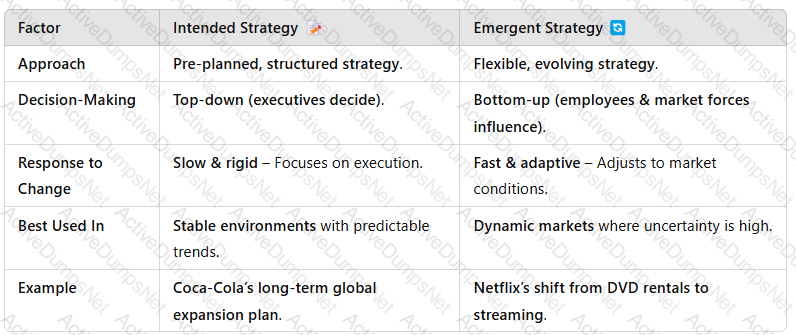 A screenshot of a computer
Description automatically generated
A screenshot of a computer
Description automatically generated
Key Takeaway:Most successful organizationsblend both approaches, usingintended strategy for stabilityandemergent strategy for adaptability.
4. Conclusion
Bothintended and emergent strategieshave strengths and weaknesses.
✅Intended strategyisbest for structured, long-term growthin stable industries.✅Emergent strategyallows forrapid adaptationin volatile markets.✅Most businesses use a combinationof both approaches, balancingplanning with flexibility.
Byintegrating intended and emergent strategies, organizations canmaintain stability while responding effectively to market changes.
XYZ is a high fashion clothing designer and wishes to complete a benchmarking exercise. Discuss priority dimensions to be measured in the benchmarking exercise and propose a strategy for completing the exercise
See the complete answer below in Explanation.
Benchmarking Exercise for XYZ – A High Fashion Clothing Designer
Introduction
Benchmarking is astrategic performance measurement toolthat helps businesses compare theirprocesses, products, and strategieswith industry leaders to identify areas for improvement.
As ahigh fashion clothing designer, XYZ must focus onkey priority dimensionssuch asproduct quality, supply chain efficiency, sustainability, brand positioning, and customer engagement. A structuredbenchmarking strategyensures that XYZ can achievecompetitive advantage, optimize operations, and align with industry best practices.
1. Priority Dimensions to be Measured in Benchmarking
XYZ should focus on the followingfive key benchmarking dimensionsto enhance its competitiveness in the luxury fashion market:
1. Product Quality and Design Innovation
✅Why it’s important?
High fashion brands compete onpremium materials, craftsmanship, and exclusivity.
Quality affectsbrand reputation, pricing strategy, and customer loyalty.
????Example:XYZ can benchmark againstGucci or Chanelby comparing fabric sourcing, production techniques, and unique design elements.
2. Supply Chain Efficiency and Lead Times
✅Why it’s important?
Speed-to-market iscritical in high fashion, especially for seasonal collections.
Efficient supply chains reduce costs and enhanceinventory management.
????Example:Zara benchmarks against luxury brandsto optimize supply chains while maintaining affordability.
????Key Metrics to Benchmark:
Supplier lead times (raw materials to finished goods).
Production cycle time (design to retail store).
Logistics and distribution efficiency.
3. Brand Positioning and Market Perception
✅Why it’s important?
A high fashion brand’s success depends onprestige, exclusivity, and perceived value.
Benchmarking against top competitors helps XYZ maintaina premium brand image.
????Example:XYZ can compare itsmarketing strategies, social media presence, and celebrity endorsementswithLouis Vuitton or Dior.
????Key Metrics to Benchmark:
Brand awareness and perception (customer surveys).
Pricing strategy compared to competitors.
Effectiveness of marketing campaigns and influencer collaborations.
4. Sustainability and Ethical Sourcing
✅Why it’s important?
Consumers expecteco-friendly, ethically produced fashion.
Sustainable brands gain a competitive edgeand attract Gen Z and millennial buyers.
????Example:Stella McCartney’s ethical fashion modelis a benchmark forsustainable materials and responsible sourcing.
????Key Metrics to Benchmark:
Use of sustainable materials (organic, recycled fabrics).
Ethical supplier compliance withfair labor practices.
Carbon footprint reduction in production and logistics.
5. Customer Engagement and Experience
✅Why it’s important?
Luxury brands thrive onpersonalized customer experiences and loyalty programs.
Omnichannel retail(physical stores + digital platforms) enhances sales and retention.
????Example:Burberry’s digital transformationprovides a seamlessluxury online shopping experience.
????Key Metrics to Benchmark:
Online vs. in-store customer engagement levels.
AI-driven personalization in e-commerce.
Customer service responsiveness and return policies.
2. Proposed Strategy for Completing the Benchmarking Exercise
To complete the benchmarking process successfully, XYZ should follow astructured benchmarking approachusing the5-step process:
Step 1: Identify Benchmarking Objectives
????Define what XYZ wants to achieve (e.g.,reducing lead times, improving sustainability).????Selectbenchmarking partners(competitors, industry leaders, cross-industry comparisons).
Step 2: Data Collection & Research
????Useprimary and secondary researchto gather data:
Primary Research:Surveys, interviews, supplier audits.
Secondary Research:Competitor reports, industry data, fashion indexes.
????Example:Studyingannual sustainability reports from high fashion brandsto benchmark against sustainability best practices.
Step 3: Analyze Performance Gaps
????Compare XYZ’scurrent performance metricswith industry benchmarks.????Identifygaps and improvement opportunities(e.g., faster supply chain, better brandmarketing).
????Example Analysis:
XYZ’ssupply chain lead time = 60 daysvs.benchmark brand = 30 days→ Strategy needed for optimization.
Step 4: Develop and Implement Improvement Strategies
????SetSMART objectives(Specific, Measurable, Achievable, Relevant, Time-bound).????Adjustsupply chain processes, brand positioning, marketing strategies, and customer experience initiatives.
????Example Action Plan:
Supply Chain:Partner withlocal European suppliersto reduce lead times.
Sustainability:Introduceorganic cotton & cruelty-free leatherin the next collection.
Step 5: Continuous Monitoring and Review
????Regularly review benchmarking outcomes.????Adjust strategies to remain competitive in the evolving high fashion market.
????Example:Chanel adapts marketing campaignsevery season to maintain exclusivity and desirability.
Conclusion
Benchmarking allows XYZ to measureproduct quality, supply chain efficiency, brand positioning, sustainability, and customer engagementagainsthigh fashion industry leaders. A structured5-step benchmarking processensures that XYZ continuously improves itsstrategic performance and maintains a competitive edge.
Discuss the difference between a merger and an acquisition. What are the main drivers and risks associated with this approach to growth compared to an organic development strategy?
See the complete answer below in Explanation.
Mergers vs. Acquisitions: Drivers, Risks, and Comparison to Organic Growth
Introduction
Businesses seeking growth can expand throughmergers and acquisitions (M&A)or byorganic development. Mergers and acquisitions involveexternal growth strategies, where companies combine forces or take over another business, whereas organic growth occursinternally through investment in operations, R&D, and market expansion.
While M&A strategies providerapid expansion and competitive advantages, they also carryintegration risks and financial complexitiescompared to organic growth.
1. Difference Between a Merger and an Acquisition
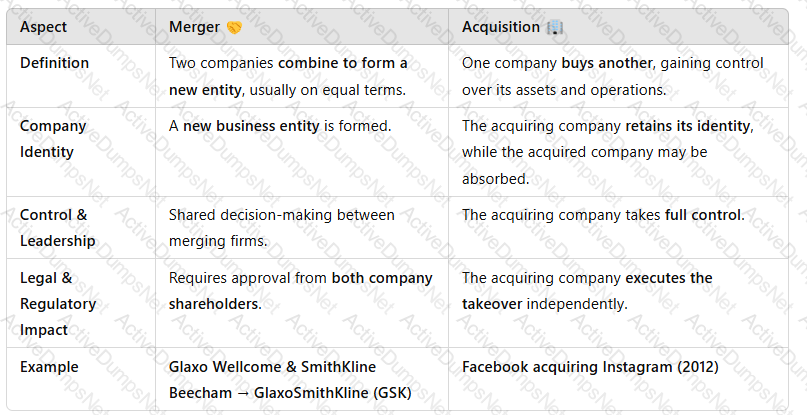 A screenshot of a computer
Description automatically generated
A screenshot of a computer
Description automatically generated
Key Takeaway:Mergers are usuallycollaborative, while acquisitions involveone company dominating another.
2. Main Drivers of Mergers & Acquisitions (M&A)????
1. Market Expansion & Faster Growth
✅Providesimmediate accessto new markets, customers, and geographies.✅Faster than organic growth, allowing firms toscale operations quickly.
????Example:Amazon’s acquisition of Whole Foodsgave it an instant presence in the grocerysector.
2. Cost Synergies & Efficiency Gains
✅Reducesduplication of functions(e.g., shared IT, supply chain).✅Achieveseconomies of scale, lowering operating costs.
????Example:Disney’s acquisition of 21st Century Foxreduced production costs by consolidating media assets.
3. Competitive Advantage & Market Power
✅Eliminates competition by absorbingrival firms.✅Strengthensbargaining power over suppliers and distributors.
????Example:Google acquiring YouTuberemoved a major competitor in the video-sharing industry.
4. Access to New Technology & Innovation
✅Fast-tracksadoption of emerging technologies.✅Avoids lengthyin-house R&D developmentcycles.
????Example:Microsoft’s acquisition of LinkedIngave it access to AI-driven professional networking tools.
3. Risks of Mergers & Acquisitions⚠️
1. Cultural & Operational Integration Challenges
❌Employees from different companies mayresist integration, leading to conflicts.❌Different corporate culturesmay result in productivity loss.
????Example:TheDaimler-Chrysler merger faileddue to cultural clashes between German and American management styles.
2. High Financial Costs & Debt Risks
❌Acquiring companiesoften take on large amounts of debt.❌M&A dealsmay overvalue the target company, leading to losses.
????Example:AOL’s acquisition of Time Warner($165 billion) resulted inhuge financial lossesdue to overvaluation.
3. Regulatory and Legal Barriers
❌Government regulators mayblock mergers due to monopoly concerns.❌Legal challenges maydelay or cancel deals.
????Example:TheEU blocked Siemens and Alstom’s rail mergerdue to competition concerns.
4. Disruption to Core Business
❌Management focus on M&A candistract from existing operations.❌Post-merger integration complexitiescan lead to delays and inefficiencies.
????Example:HP’s acquisition of Compaqresulted in years of internal restructuring, impacting performance.
4. Comparison: M&A vs. Organic Growth
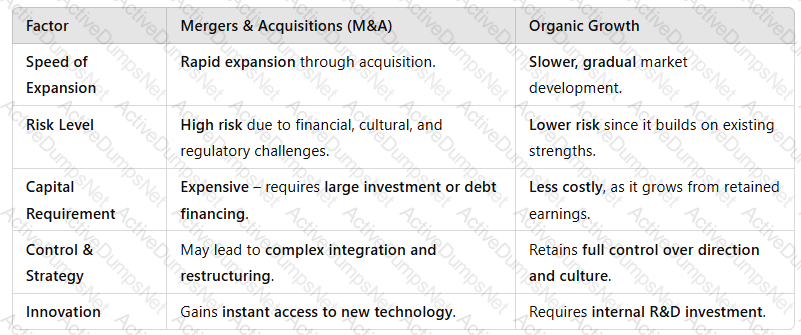 A screenshot of a computer
Description automatically generated
A screenshot of a computer
Description automatically generated
Key Takeaway:M&A providesfast expansionbut comes withhigher risks, whereas organic growth isslower but more sustainable.
5. Conclusion
Mergers and acquisitions offera fast-track to market leadership, providinggrowth, cost synergies, and competitive advantages. However, they also carrysignificant financial, cultural, and regulatory riskscompared to organic growth.
✅Best for:Companies needingrapid expansion, technology access, or competitive positioning.❌Risky when:Poor cultural integration, excessive debt, or regulatory obstacles arise.
Businesses mustcarefully assess strategic fit, financial feasibility, and post-merger integration plansbefore choosing M&A as a growth strategy.
Discuss the role and influence of industry regulators and international bodies in the business environment.
See the complete answer below in Explanation.
The Role and Influence of Industry Regulators and International Bodies in the Business Environment
Introduction
Industry regulators and international bodies play acritical role in shaping the business environmentby enforcing regulations, setting industry standards, and ensuring fair competition. These organizations influence how businesses operate, impacting areas such astrade, finance, environmental sustainability, labor practices, and consumer protection.
Companies must comply with regulations set by bothdomestic industry regulatorsandglobal institutionsto maintain legal and ethical business operations.
1. Role of Industry Regulators
Industry regulators aregovernment-appointed or independent organizationsthat oversee specific sectors to ensure compliance with laws and standards. Their key functions include:
✅Enforcing Compliance– Ensuring companies adhere to legal requirements (e.g., financial reporting, safety regulations).✅Promoting Fair Competition– Preventing monopolies and anti-competitive practices.✅Consumer Protection– Safeguarding consumer rights and ensuring product/service quality.✅Regulating Market Entry and Operations– Setting standards for licensing, pricing, and ethical conduct.
????Example of Industry Regulators
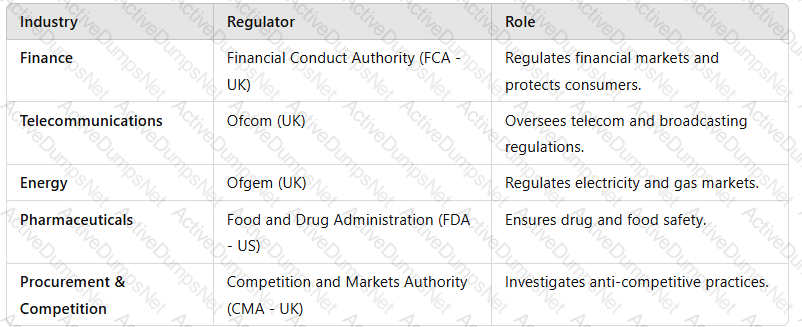 A screenshot of a computer
Description automatically generated
A screenshot of a computer
Description automatically generated
Case Example:TheUK’s Competition and Markets Authority (CMA)blockedMicrosoft’s acquisition of Activision Blizzarddue to concerns over market dominance in cloud gaming.
2. Role of International Bodies
International bodies setglobal regulations, trade policies, and ethical standardsthat influence businesses operating across borders.
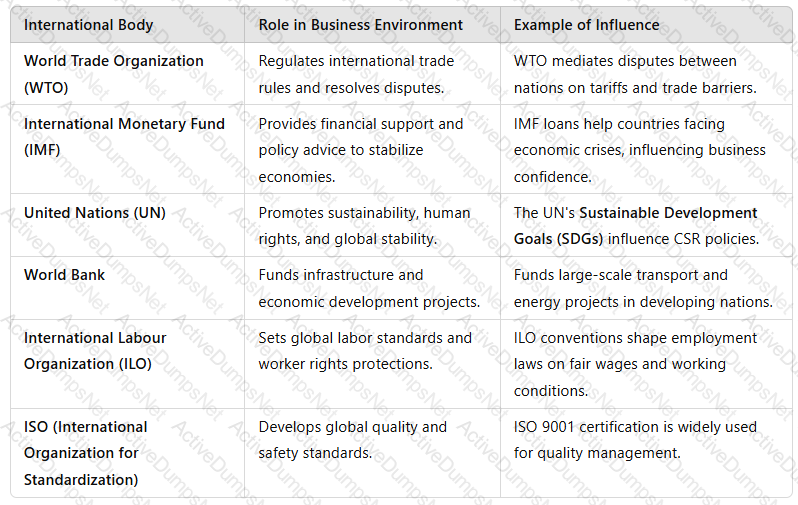 A table with text on it
Description automatically generated
A table with text on it
Description automatically generated
Case Example:TheWTO’s intervention in Brexit trade negotiationsaffected tariffs and supply chain costs for UK-based companies.
3. Influence of Industry Regulators and International Bodies on Business Strategy
Businesses must align their strategies with regulatory and international frameworks toensure compliance and avoid financial or reputational risks.
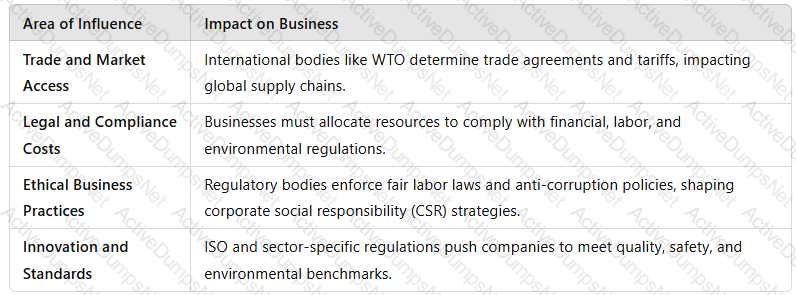 A screenshot of a computer
Description automatically generated
A screenshot of a computer
Description automatically generated
Example:TheEU’s General Data Protection Regulation (GDPR)forced global companies to enhancedata protection policiesor face heavy fines.
4. Advantages and Disadvantages of Regulatory and International Influence
✅Advantages
Promotes Stability & Fair Competition– Reduces market manipulation and corruption.
Protects Consumers & Employees– Ensures safety, fair wages, and ethical standards.
Encourages Innovation & Sustainability– Businesses invest in R&D to meet regulatory requirements.
Facilitates Global Trade– International trade agreements create business opportunities.
❌Disadvantages
Regulatory Burdens & Compliance Costs– Strict laws increase operational costs.
Trade Barriers & Bureaucracy– Lengthy regulatory approval processes slow down market entry.
Risk of Overregulation– Too many rules can stifle competition and innovation.
????Example:TheEU Emissions Trading System (EU ETS)requires manufacturers topay for carbon emissions, increasing operational costs.
Conclusion
Industry regulators and international bodiesshape the business environmentby enforcing laws, ensuring ethical practices, and facilitating global trade. Companies must proactivelymonitor regulatory changes, integrate compliance into strategic planning, and adapt to international standardsto maintain market competitiveness and sustainability.
